DOCSIS 2.0 ATDMA Configuration on MC5x20S and MC28U Linecards
Available Languages
Contents
Introduction
Advanced Time Division Multiple Access (ATDMA) is a Data-over-Cable Service Interface Specifications (DOCSIS) 2.0 extension for upstream (US) capacity. It provides a larger US channel of up to 6.4 MHz at 5.12 Msym/sec and provides higher modulation schemes such as quadrature amplitude modulation 8 (8-QAM), 32-QAM, and 64-QAM. ATDMA also provides more physical layer robustness in the form of sixteen T-bytes of forward error correction (FEC), US burst interleaving, and a 24-tap equalizer.
The advanced physical layer (PHY) present on newer linecards also provides analog-to-digital conversion, digital signal processing, and ingress cancellation that can help older DOCSIS 1.0 modems. For more information about the new advanced PHY capabilities, refer to Advanced PHY Layer Technologies for High-Speed Data Over Cable.
64-QAM at 6.4 MHz
Figure 1 shows a 6.4 MHz-wide channel using 64-QAM on a spectrum analyzer. The channel width is apparent, but the modulation scheme is not. The appearance is also affected by analyzer settings and the traffic pattern. Use a random pattern from a traffic generator to yield a smoother trace.
Figure 1 – 64-QAM at 6.4 MHz 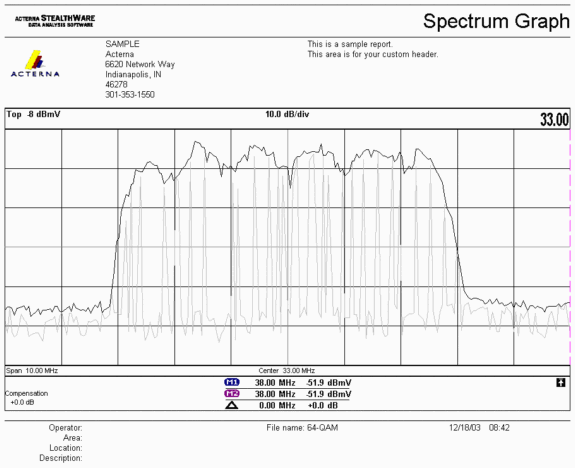
DOCSIS Channel Types
DOCSIS 2.0 has introduced channel types to distinguish different modes of upstream channel operation. These types are:
-
Type 1—DOCSIS 1.0 and 1.1 only.
-
Type 2—DOCSIS 1.x and ATDMA (mixed mode).
DOCSIS 1.x cable modems (CMs) use interval usage codes (IUCs) 5 and 6 while DOCSIS 2.0 CMs transmit in newly defined IUCs 9, 10, and 11, which might use higher modulation orders not available in 1.x. IUC 11 was added for unsolicited grant service (UGS) flows. For modulation profile explanations, refer to Understanding Upstream Modulation Profiles.
-
Type 3—DOCSIS 2.0 only.
This channel type uses MAC message type 29 in the Upstream Channel Descriptor (UCD) sent on the downstream (DS) channel to ensure that only 2.0 CMs attempt to register. This prevents 1.x CMs from ever attempting to use this US channel. Also, another IUC was added for unsolicited grant service (UGS) flows. This is known as IUC 11 for advanced UGS (a-ugs).
Type 3 DOCSIS channels have 2 submodes:
-
Type 3A for ATDMA
-
Type 3S for Synchronous Code Division Multiple Access (SCDMA)—This submode will not be available on Cisco’s cable modem termination system (CMTS) until late 2004.
-
Benefits
DOCSIS 2.0 provides greater spectral efficiency, better use of existing channels, higher throughput in the US direction (up to 30.72 Mbps), higher per-modem speed with more packets-per-second (PPS), and wider channels (which provide better statistical multiplexing). A 6.4 MHz-wide channel is statistically better than two 3.2 MHz-wide channels, and it only require one US port instead of two.
In conjunction with DOCSIS 2.0 support, the latest generation of CMTS linecards support other features, such as improved ingress cancellation allowing higher orders of modulation and slight frequency overlap. This last point is not recommended, but it can be shown to work. Ingress cancellation proves to be robust against worst-case plant impairments such as common path distortion (CPD), citizen band (CB), short-wave radio, and ham radio. This opens unused portions of the upstream spectrum and provides insurance for lifeline services.
ATDMA also enhances flexibility when used in combination with Virtual Interfaces and Load Balancing. A 1x1 MAC domain might make more sense for commercial customers, while a 1x7 MAC domain might be better suited for residential.
Restrictions
These are some of the current restrictions to ATDMA:
-
It does not work with load balancing, because US load balance weights are unknown when using Type 2 US channels (mixed mode). Weights are related to the aggregate speed of the “pipe.” In a mixed (DOCSIS 1.x and 2.0) environment, the 1.x CMs could have a weight of 10.24 Mbps and the 2.0 CMs could have a weight of 15 Mbps.
-
It is available on the MC5x20S card in IOS® Software Release 12.2(15)BC2a and later.
-
It does not fully work with Advanced Spectrum Management, because there are only two configurable thresholds, but three might be warranted when using higher orders of modulation with ATDMA.
-
The highest channel width for mixed mode is 3.2 MHz, so 2.0 CMs are limited by 1.x CMs.
-
There is no SCDMA support or “full” DOCSIS 2.0-CableLabs qualification until the MC5x20T card is released near the end of 2004.
CM Registration in a Mixed Environment
Provisioning a cable modem (CM) with its configuration file—in either 1.0 or 1.1 mode—is independent of the PHY mode used (time division multiplex access [TDMA], ATDMA, or SCDMA). Setting type, length, value (TLV) 39 equal to 0 prevents a 2.0 CM from coming up in 2.0 mode. If TLV 39 is omitted (the default) or is set equal to 1, a 2.0 CM tries to come online in 2.0 mode.
TLV 40 is used to enable test modes in 2.0 CMs. This is specified in section C.1.1.20 of SP-RFIv2.0-I02-020617 and further specified as belonging in the DOCSIS configuration file in section D.3.1. This field must be included in the CMTS message intergrity check (MIC) calculation. Refer to DOCSIS 2.0 RFI Appendix C.1.1.19 ![]() , Page 336.
, Page 336.
Figure 2 shows the file that must be edited to be able to configure TLV 39. The file is located at: C:\Program Files\Cisco Systems\Cisco Broadband Configurator\docsisconfig\resources. Right-click DOCSIS_Config-properties and open it with a text editor.
Figure 2 – Configurator Application to Edit 
Look for RemoveUnknownTypeTLV=no and ensure that it reads no. The file also contains these lines:
# This field is editable. # This specifies whether the non-DOCSIS, non-PacketCable TLVs (type in range 128 to 250) & # DOCSIS 2.0 specific TLVs 39 & 40 should be removed when save generated config file.
This allows the user to set DOCSIS TLV 39 in the Configurator application. Figure 3 shows the Text mode of a DOCSIS 1.1 CM file while using the Configurator application.
Figure 3 – Configurator Text Mode 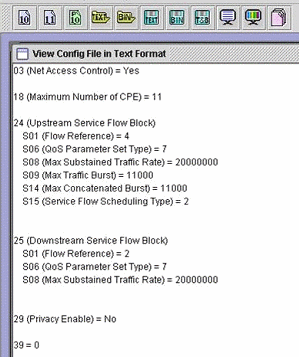
Insert 39 = 0 to force a 2.0 CM to register in 1.x mode, or insert 39 = 1 for 2.0 mode. After saving and re-opening, your change appears like this:

Conversely, the line shows Yes when you set it to 1.
Key Points
Be sure that the channel width fits where intended. For example, an 8 MHz center frequency is not legal because a 6.4 MHz channel would extend beyond the band edge of 5 MHz. When using spectrum groups, verify that the band is big enough for the intended channel. Also be aware that tick sizes change automatically with channel width changes. A 6.4 MHz-wide channel uses a minislot of 1 tick by default; 3.2 MHz, 2 ticks; 1.6 MHz, 4 ticks; 0.8 MHz, 8 ticks, and so forth.
Linecards might use different US chips and require different modulation profiles for each. The MC5x20S linecard uses a TI4522 for US physical demodulation and the MC28U uses the Broadcom 3138 for US demodulation. Both linecards take advantage of the new DOCSIS MAC-PHY Interface (DMPI) specified in DOCSIS 2.0. DMPI provides flexibility for CMTS vendors like Cisco to make use of a variety of DOCSIS chip vendors and to provide a less expensive product for CMTS users.
Preambles and Constellations
Another key point is that ATDMA preambles are always Quadrature Phase-Shift Keying (QPSK) 0 or 1, where 0 denotes a low-power preamble and 1 denotes a high-power preamble. Original 1.x CMs use a preamble that is the same as the data, whether it is QPSK or 16-QAM. Because the preamble was a consistent pattern between two symbol landings, it was essentially bi-phase shift keying (BPSK). Figure 4 shows the new ATDMA preamble constellations.
Figure 4 – ATDMA Preamble Constellations 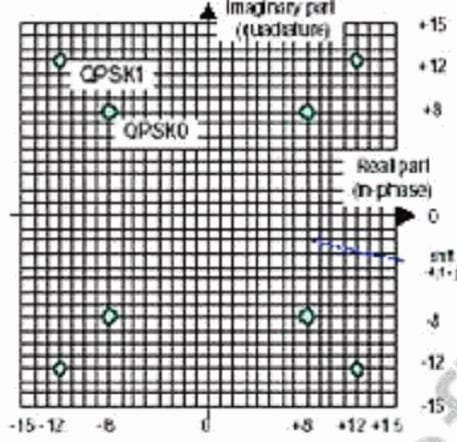
Figure 5 displays 16-QAM and 64-QAM constellations, respectively, while Figure 6 displays some less commonly used constellations, such as 8-QAM and 32-QAM.
Figure 5 – 16-QAM and 64-QAM Constellations 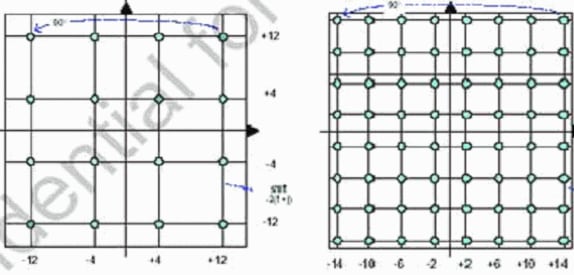
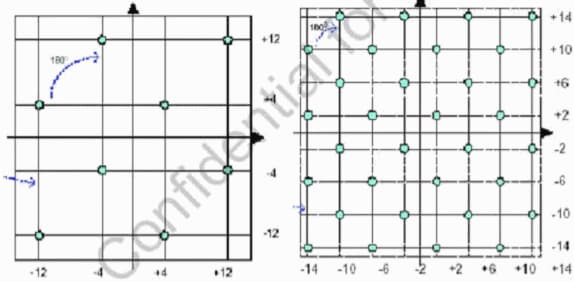
Upstream Power Levels
DOCSIS provides power level ranges based on the US channel width. Table 1 lists the power ranges for the associated channel widths.
Table 1 – Channel Width versus Power Range| Channel Width (MHz) | Range @ CMTS (dBmV) |
|---|---|
| 0.2 | –16 to 14 |
| 0.4 | –13 to 17 |
| 0.8 | –10 to 20 |
| 1.6 | –7 to 23 |
| 3.2 | –4 to 26 |
| 6.4 | –1 to 29 |
Note: Doubling the channel width decreases the carrier-to-noise ratio (CNR) by 3 dB. If Cisco kept the same power spectral density (PSD), CMs would have the same CNR, but you could run the chance of CMs maxing out. For more information about upstream optimization, refer to How to Increase Return Path Availability and Throughput.
The modulation used also dictates CM maximum power output. DOCSIS states 58 dBmV for QPSK, 55 dBmV for 16-QAM, 54 dBmV for 64-QAM, and 53 dBmV for SCDMA. Most CMs, however, will do more.
Configurations
All commands and command outputs are as seen on a uBR10k running Cisco IOS Software Release 12.2(15)BC2a. While in the cable interface configuration, the US port can be assigned a docsis-mode as shown in this example:
ubr10k(config-if)# cable upstream 0 docsis-mode ? atdma DOCSIS 2.0 ATDMA-only channel tdma DOCSIS 1.x-only channel tdma-atdma DOCSIS 1.x and DOCSIS 2.0 mixed channel
If ATDMA mode is selected, 1.x CMs should not even range on this US, and this information is displayed:
ubr10k(config-if)# cable upstream 0 docsis-mode atdma %Docsis mode set to ATDMA-only (1.x CMs will go offline) %Modulation profile set to 221
These channel widths are available:
ubr10k(config-if)# cable upstream 0 channel-width ? 1600000 Channel width 1600 kHz, symbol rate 1280 ksym/s 200000 Channel width 200 kHz, symbol rate 160 ksym/s 3200000 Channel width 3200 kHz, symbol rate 2560 ksym/s 400000 Channel width 400 kHz, symbol rate 320 ksym/s 6400000 Channel width 6400 kHz, symbol rate 5120 ksym/s 800000 Channel width 800 kHz, symbol rate 640 ksym/s
If a 6.4 MHz channel width is selected, the minislot changes automatically to 1 tick, and this information is displayed:
ubr10k(config-if)# cable upstream 0 channel-width 6400000 %With this channel width, the minislot size is now changed to 1 tick
Verify the interface settings with the show controller command:
ubr10k# show controller cable6/0/0 upstream 0 Cable6/0/0 Upstream 0 is up Frequency 16 MHz, Channel Width 6.400 MHz, 64-QAM Symbol Rate 5.120 Msps This upstream is mapped to phy port 0 Spectrum Group is overridden SNR - Unknown - no modems online. Nominal Input Power Level 0 dBmV, Tx Timing Offset 0 Ranging Backoff auto (Start 0, End 3) Ranging Insertion Interval auto (60 ms) Tx Backoff Start 3, Tx Backoff End 5 Modulation Profile Group 221 Concatenation is enabled Fragmentation is enabled part_id=0x0952, rev_id=0x00, rev2_id=0x00 nb_agc_thr=0x0000, nb_agc_nom=0x0000 Range Load Reg Size=0x58 Request Load Reg Size=0x0E Minislot Size in number of Ticks is = 1 Minislot Size in Symbols = 32 Bandwidth Requests = 0x0 Piggyback Requests = 0x0 Invalid BW Requests= 0x0 Minislots Requested= 0x0 Minislots Granted = 0x0 Minislot Size in Bytes = 24 Map Advance (Dynamic) : 2180 usecs UCD Count = 313435 ATDMA mode enabled
The running interface appears like this:
ubr10k# show running interface cable6/0/0 interface Cable6/0/0 no ip address cable bundle 1 cable downstream annex B cable downstream modulation 64qam cable downstream interleave-depth 32 cable downstream frequency 453000000 cable downstream channel-id 0 no cable downstream rf-shutdown cable upstream max-ports 5 cable upstream 0 connector 0 cable upstream 0 frequency 16000000 cable upstream 0 docsis-mode atdma cable upstream 0 power-level 0 cable upstream 0 channel-width 6400000 cable upstream 0 minislot-size 1 cable upstream 0 modulation-profile 221 cable upstream 0 s160-atp-workaround no cable upstream 0 shutdown !--- Output suppressed. cable upstream 4 connector 16 cable upstream 4 frequency 15008000 cable upstream 4 power-level 0 cable upstream 4 channel-width 1600000 cable upstream 4 minislot-size 4 cable upstream 4 modulation-profile 21 cable upstream 4 s160-atp-workaround no cable upstream 4 shutdown
Modulation Profiles
The introduction of docsis-mode allows the configuration of a US channel to a desired mode. Each mode has its own “valid” profile range:
-
TDMA—cable modulation-profile xx (where xx equals 01 to 99) TDMA mode requires modulation profile numbers less than 100.
-
ATDMA-TDMA—cable modulation-profile 1xx (where xx equals 01 to 99, thus 101 to 199)
-
ATDMA—cable modulation-profile 2xx (where xx equals 01 to 99, thus 201 to 299)
New ATDMA bursts, known as interval usage codes (IUCs), are introduced for mixed and ATDMA-only DOCSIS modes.
-
IUC 9—advanced PHY short grant (a-short)
-
IUC 10—advanced PHY long grant (a-long)
-
IUC 11—advanced PHY UGS (a-ugs; ATDMA-only mode)
 Caution: The show run and show cable modulation commands might not be accurate when viewing the modulation profiles. Be sure to use show cable modulation cablex/y upstream z in Cisco IOS Software Release 12.2(15)BC2a to display the actual profile used.
Caution: The show run and show cable modulation commands might not be accurate when viewing the modulation profiles. Be sure to use show cable modulation cablex/y upstream z in Cisco IOS Software Release 12.2(15)BC2a to display the actual profile used.
Note: Each linecard has a “valid” numbering scheme: 1 to 10 for legacy cards, x2x for the MC5x20, and x4x for the MC28U linecard. Table 2 lists the different scenarios:
Table 2 – Modulation Profile Number for Each DOCSIS Mode| Profile Numbers | Linecards | DOCSIS Mode |
|---|---|---|
| 1–10 | MC28C & MC16x | TDMA |
| 21–30 | MC5x20S | TDMA |
| 121–130 | MC5x20S | TDMA-ATDMA |
| 221–230 | MC5x20S | ATDMA |
| 41–50 | MC28U | TDMA |
| 141–150 | MC28U | TDMA-ATDMA |
| 241–250 | MC28U | ATDMA |
| 361–370 | MX5x20T | SCDMA |
Example of Cable Modulation-Profile 121 - Mixed Mode
Table 3 is an example of a modulation profile for the MC5x20S linecard for ATDMA-TDMA, mixed mode. The bold text indicates Cisco-constructed profiles.
Table 3 – Modulation Profile Settings for Mixed Mode| IUC | Entry | Description |
|---|---|---|
| 10 | a-long | Advanced PHY Long Grant Burst |
| 9 | a-short | Advanced PHY Short Grant Burst |
| 11 | a-ugs | Advanced PHY Unsolicited Grant Burst |
| 1 | initial | Initial Ranging Burst |
| 6 | long | Long Grant Burst |
| mix-high | Create default QPSK/ATDMA QAM-64 mix profile | |
| mix-low | Create default QPSK/ATDMA QAM-16 mix profile | |
| mix-mid | Create default QPSK/ATDMA QAM-32 mix profile | |
| mix-qam | Create default QAM-16/ATDMA QAM-64 mix profile | |
| qam-16 | Create default QAM-16 profile | |
| qpsk | Create default QPSK profile | |
| 2 | reqdata | Request/data Burst |
| 3 | request | Request Burst |
| robust-mix-high | Create robust QPSK/ATDMA QAM-64 mix modulation profile | |
| robust-mix-mid | Create robust QPSK/ATDMA QAM-32 mix modulation profile | |
| robust-mix-qam | Create robust QAM-16/ATDMA QAM-64 mix modulation profile | |
| 5 | short | Short Grant Burst |
| 4 | station | Station Ranging Burst |
These examples show the correct command to display profiles assigned to specific USs:
5x20S in Mixed Mode Using 2-Tick Minislots at 3.2 MHz Channel Width
ubr10k# show cable modulation-profile cable6/0/0 upstream 0
Mod IUC Type Pre Diff FEC FEC Scrm Max Grd Last Scrm Pre Pre RS
len enco T k seed B time CW offst Type
121 request qpsk 32 no 0x0 0x10 0x152 0 22 no yes 0 qpsk0 na
121 initial qpsk 64 no 0x5 0x22 0x152 0 48 no yes 0 qpsk0 na
121 station qpsk 64 no 0x5 0x22 0x152 0 48 no yes 0 qpsk0 na
121 short qpsk 64 no 0x3 0x4E 0x152 12 22 yes yes 0 qpsk0 na
121 long qpsk 64 no 0x9 0xE8 0x152 0 22 yes yes 0 qpsk0 na
121 a-short qpsk 64 no 0x3 0x4E 0x152 12 22 yes yes 0 qpsk0 no
121 a-long qpsk 64 no 0x9 0xE8 0x152 0 22 yes yes 0 qpsk0 no
121 a-ugs qpsk 64 no 0x9 0xE8 0x152 0 22 yes yes 0 qpsk0 no
28U in Mixed Mode Using 2-Tick Minislots at 3.2 MHz Channel Width
ubr7246-2# show cable modulation-profile cable6/0 upstream 0
Mod IUC Type Pre Diff FEC FEC Scrm Max Grd Last Scrm Pre Pre RS
len enco T k seed B time CW offst Type
141 request qpsk 64 no 0x0 0x10 0x152 0 8 no yes 396 qpsk no
141 initial qpsk 128 no 0x5 0x22 0x152 0 48 no yes 6 qpsk no
141 station qpsk 128 no 0x5 0x22 0x152 0 48 no yes 6 qpsk no
141 short qpsk 100 no 0x3 0x4E 0x152 35 25 yes yes 396 qpsk no
141 long qpsk 80 no 0x9 0xE8 0x152 0 135 yes yes 396 qpsk no
141 a-short 64qam 100 no 0x9 0x4E 0x152 14 14 yes yes 396 qpsk1 no
141 a-long 64qam 160 no 0xB 0xE8 0x152 96 56 yes yes 396 qpsk1 no
141 a-ugs 64qam 160 no 0xB 0xE8 0x152 96 56 yes yes 396 qpsk1 no
Example of Cable Modulation-Profile 221 - ATDMA Mode
Table 4 is an example of a modulation profile for the MC5x20 linecard for ATDMA mode. The bold text indicates Cisco-constructed profiles.
Table 4 – Modulation Profile Settings for ATDMA Mode| Entry | Description |
|---|---|
| a-long | Advanced PHY Long Grant Burst |
| a-short | Advanced PHY Short Grant Burst |
| a-ugs | Advanced PHY Unsolicited Grant Burst |
| initial | Initial Ranging Burst |
| mix-high | Create default ATDMA QPSK/QAM-64 mix profile |
| mix-low | Create default ATDMA QPSK/QAM-16 mix profile |
| mix-mid | Create default ATDMA QPSK/QAM-32 mix profile |
| mix-qam | Create default ATDMA QAM-16/QAM-64 mix profile |
| qam-16 | Create default ATDMA QAM-16 profile |
| qam-32 | Create default ATDMA QAM-32 profile |
| qam-64 | Create default ATDMA QAM-64 profile |
| qam-8 | Create default ATDMA QAM-8 profile |
| qpsk | Create default ATDMA QPSK profile |
| reqdata | Request/data Burst |
| request | Request Burst |
| robust-mix-high | Create robust ATDMA QPSK/QAM-64 mix modulation profile |
| robust-mix-low | Create robust ATDMA QPSK/QAM-16 mix modulation profile |
| robust-mix-mid | Create robust ATDMA QPSK/QAM-32 mix modulation profile |
| station | Station Ranging Burst |
5x20S in ATDMA Mode Using 1-Tick Minislots at 6.4 MHz Channel Width
ubr10k# show cable modulation-profile cable6/0/0 upstream 0
Mod IUC Type Pre Diff FEC FEC Scrm Max Grd Last Scrm Pre Pre RS
len enco T k seed B time CW offst Type
221 request qpsk 32 no 0x0 0x10 0x152 0 22 no yes 0 qpsk0 no
221 initial qpsk 64 no 0x5 0x22 0x152 0 48 no yes 64 qpsk0 no
221 station qpsk 64 no 0x5 0x22 0x152 0 48 no yes 64 qpsk0 no
221 a-short 64qam 64 no 0x6 0x4E 0x152 6 22 yes yes 64 qpsk1 no
221 a-long 64qam 64 no 0x8 0xE8 0x152 0 22 yes yes 64 qpsk1 no
221 a-ugs 64qam 64 no 0x8 0xE8 0x152 0 22 yes yes 64 qpsk1 no
28U in ATDMA Mode Using 1-Tick Minislots at 6.4 MHz Channel Width
ubr7246-2# show cable modulation-profile cable6/0 upstream 0
Mod IUC Type Pre Diff FEC FEC Scrm Max Grd Last Scrm Pre Pre RS
len enco T k seed B time CW offst Type
241 request qpsk 64 no 0x0 0x10 0x152 0 8 no yes 396 qpsk0 no
241 initial qpsk 128 no 0x5 0x22 0x152 0 48 no yes 6 qpsk0 no
241 station qpsk 128 no 0x5 0x22 0x152 0 48 no yes 6 qpsk0 no
241 a-short 64qam 100 no 0x9 0x4E 0x152 6 10 yes yes 396 qpsk1 no
241 a-long 64qam 160 no 0xB 0xE8 0x152 96 56 yes yes 396 qpsk1 no
241 a-ugs 16qam 108 no 0x9 0xE8 0x152 18 16 yes yes 396 qpsk1 no
For more information about upstream modulation profiles, refer to Understanding Upstream Modulation Profiles.
Verification of ATDMA Configurations and Traffic
To verify that modems are using ATDMA when intended, issue these commands to display the CM capabilities and configurations:
ubr7246-2# show cable modem mac
MAC Address MAC Prim Ver QoS Frag Cnct PHS Priv DS US
State Sid Prov Saids Sids
0090.8343.9c07 online 11 DOC1.1 DOC1.1 yes yes yes BPI 22 5
00e0.6f1e.3246 online 1 DOC2.0 DOC1.1 yes yes yes BPI+ 255 16
That command displays the CM capabilities, not necessarily what it is doing.
ubr7246-2# show cable modem phy
MAC Address I/F Sid USPwr USSNR Timing uReflec DSPwr DSSNR Mode
(dBmV) (dB) Offset (dBc) (dBmV) (dB)
0006.5305.ad7d C3/0/U0 1 41.03 31.13 2806 16 -1.00 34.05 tdma
0000.39f7.8e6b C6/0/U0 5 50.01 36.12 1469 22 0.02 34.08 atdma
000b.06a0.7120 C6/1/U1 1 32.00 36.12 2010 41 6.02 41.05 tdma
That command displays the mode and other physical layer settings that the CM is using. Some of these entries do not show up unless remote-query is configured.
ATDMA Traffic Verification
When verifying ATDMA traffic, it is easiest to monitor one cable modem on a US. The ping command does not get concatenated, so it is an easy test to verify that short grants are used for small packets, such as 64 byte Ethernet frames. Issue the ping command with 46 bytes from the CMTS to the CM.
First, verify the proper settings, such as modulation profile, running configuration, and CM type.
-
Issue this command:
ubr7246-2# show cable modulation-profile cable6/0 upstream 0 242 a-short 64qam 100 no 0x9 0x4E 0x152 7 14 yes yes 396 qpsk1 no 242 a-long 64qam 160 no 0xB 0xE8 0x152 245 255 yes yes 396 qpsk1 no
-
Issue this command:
ubr7246-2# show cable modem cable6/0 000b.06a0.7116 10.200.100.158 C6/0/U0 online 11 1.00 2065 0 N
-
Ping the intended IP address and verify that a-short slots increment appropriately.
They might increment more than anticipated because of Simple Network Management Protocol (SNMP) traffic or station maintenance.
-
Issue this command:
ubr7246-2# show interface cable6/0 mac-scheduler 0 | inc Slots ATDMA Short Grant Slots 2100, ATDMA Long Grant Slots 20871
-
Issue this command:
ubr7246-2# ping Protocol [ip]: Target IP address: 10.200.100.158 Repeat count [5]: 1000 Datagram size [100]: 46 Timeout in seconds [2]: 1 Extended commands [n]: Sweep range of sizes [n]: Type escape sequence to abort. Sending 1000, 46-byte ICMP Echos to 10.200.100.158, timeout is 1 seconds: !!!!!!!!!!!!!!!!!!!!!!!!!!!!!!!!!!!!!!!!!!!!!!!!!!!!!!!!!!!!!!!!!!!!!! !!!!!!!!!!!!!!!!!!!!!!!!!!!!!!!!!!!!!!!!!!!!!!!!!!!!!!!!!!!!!!!!!!!!!! Success rate is 100 percent (1000/1000), round-trip min/avg/max = 1/3/28 ms
-
Issue this command:
ubr7246-2# show interface cable6/0 mac-scheduler 0 | inc Slots ATDMA Short Grant Slots 3100, ATDMA Long Grant Slots 20871
-
An easy way to verify that long grants are used for large packets, such as 1518 byte Ethernet frames, is to issue the ping command with 1500 bytes from the CMTS to the CM.
-
Issue this command:
ubr7246-2# show interface cable6/0 mac-scheduler 0 | inc Slots ATDMA Short Grant Slots 3281, ATDMA Long Grant Slots 20871
-
Ping with 1500 byte Ethernet frames to verify ATDMA Long traffic is used correctly.
ubr7246-2# ping Protocol [ip]: Target IP address: 10.200.100.158 Repeat count [5]: 1000 Datagram size [100]: 1500 Timeout in seconds [2]: 1 Extended commands [n]: Sweep range of sizes [n]: Type escape sequence to abort. Sending 1000, 1500-byte ICMP Echos to 10.200.100.158, timeout is 1 seconds: !!!!!!!!!!!!!!!!!!!!!!!!!!!!!!!!!!!!!!!!!!!!!!!!!!!!!!!!!!!!!!!!!!!!!! !!!!!!!!!!!!!!!!!!!!!!!!!!!!!!!!!!!!!!!!!!!!!!!!!!!!!!!!!!!!!!!!!!!!!! Success rate is 100 percent (1000/1000), round-trip min/avg/max = 4/5/36 ms
-
Issue this command:
ubr7246-2# show interface cable6/0 mac-scheduler 0 | inc Slots ATDMA Short Grant Slots 3515, ATDMA Long Grant Slots 21871
Spectrum Analyzer Verification
Another way to verify the physical layer attributes is to view the US packet in the time domain of a spectrum analyzer. Figure 7 shows a 1518 byte packet using 64-QAM at 6.4 MHz.
Figure 7 – 1518 Byte Packet Using 64-QAM at 6.4 MHz 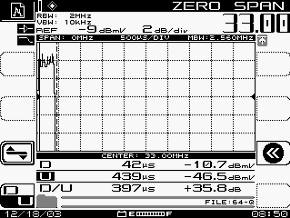
The packet only requires about 400 µs because it is using a high modulation scheme and symbol rate.
Figure 8 shows the same packet using 16-QAM at 3.2 MHz.
Figure 8 – 1518 Byte Packet Using 16-QAM at 3.2 MHz 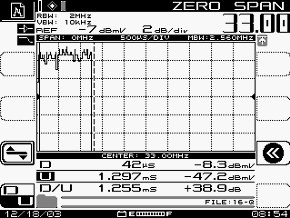
The packet requires about 1200 µs because it is using a lower modulation scheme and symbol rate. The throughput of 64-QAM at 6.4 MHz is approximately 30 Mbps; compare that to the throughput of 16-QAM at 3.2 MHz, which is approximately 10 Mbps. The difference is a factor of three, which coincides with a three times longer packet time.
Figure 9 shows a 1518 byte packet using QPSK at 3.2 MHz.
Figure 9 – 1518 Byte Packet Using QPSK at 3.2 MHz 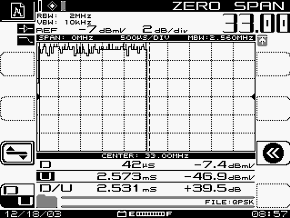
The packet requires about 2500 µs because it is using the lowest modulation scheme and 2.56 Msym/sec symbol rate. QPSK at 3.2 MHz is approximately 5 Mbps and is two times slower than Figure 8, thus giving a packet that takes two times longer to serialize.
Summary
Cisco will deliver DOCSIS 2.0, Advanced PHY, with these features:
-
Cisco application-specific integrated circuit (ASIC) MAC (DMPI Interface is a 2.0 Requirement)
-
Texas Instruments (TI) ATDMA US, Broadcom DS (5x20), Broadcom US & DS (28U)
-
Integrated Upconverter
-
Integrated Spectrum Management
-
Distributed Processing
-
Flexible US and DS Assignment (Virtual Interfaces)
-
Dense Connector (5x20)
If your reason for using ATDMA is for faster per-modem speeds, then many other parameters must be changed, such as minislot ticks, modulation profile, maximum burst settings, cable default-phy-burst, and other settings. For more information, refer to Understanding Data Throughput in a DOCSIS World.
There are other factors that can directly affect the performance of your cable network, such as the quality of service (QoS) profile, cable plant noise, rate-limiting, node combining, over-utilization, and so forth. Most of these are discussed in detail in Troubleshooting Slow Performance in Cable Modem Networks and Understanding Data Throughput in a DOCSIS World.
Note: Ensure that 1.0 CMs, which can not fragment, have a maximum burst less than 2000 bytes.
One state that might show up in the show cab modem command is reject(na), which indicates a reject nack. Reject(na) occurs in these situations:
-
When the modem sends back a “Registration NACK” to the CMTS after receiving a Registration Response from the CMTS.
-
If the DOCSIS 1.1 (or later) CM fails to send back a “Registration ACK” within the correct period of time.
Related Information
Revision History
| Revision | Publish Date | Comments |
|---|---|---|
1.0 |
04-Oct-2005 |
Initial Release |
Contact Cisco
- Open a Support Case

- (Requires a Cisco Service Contract)
 Feedback
Feedback